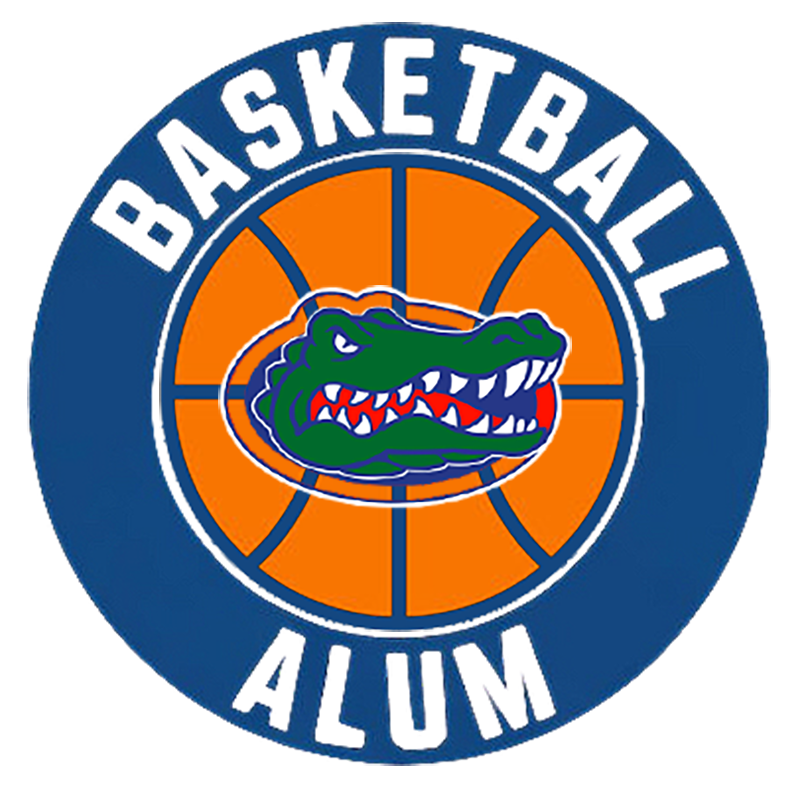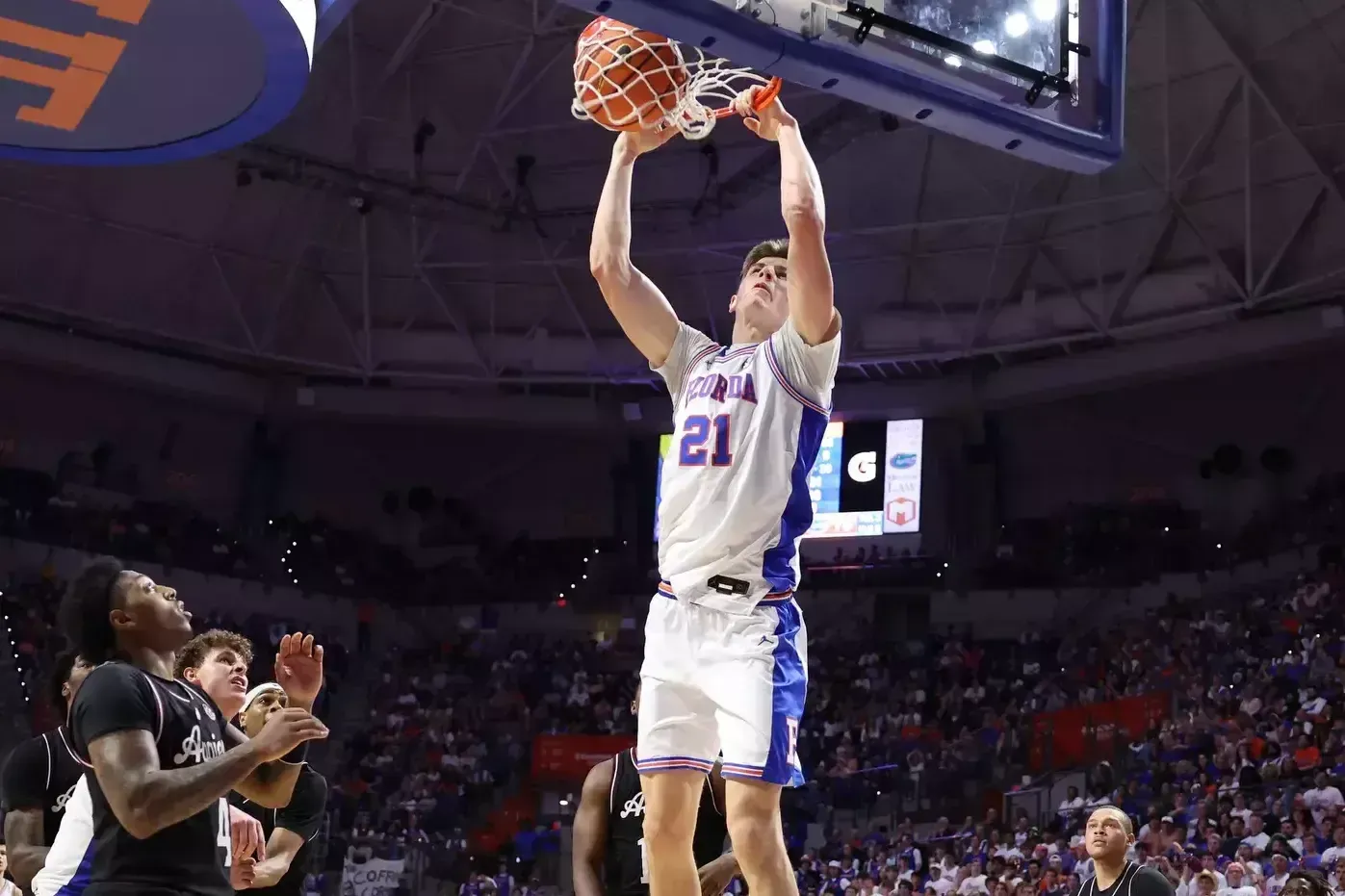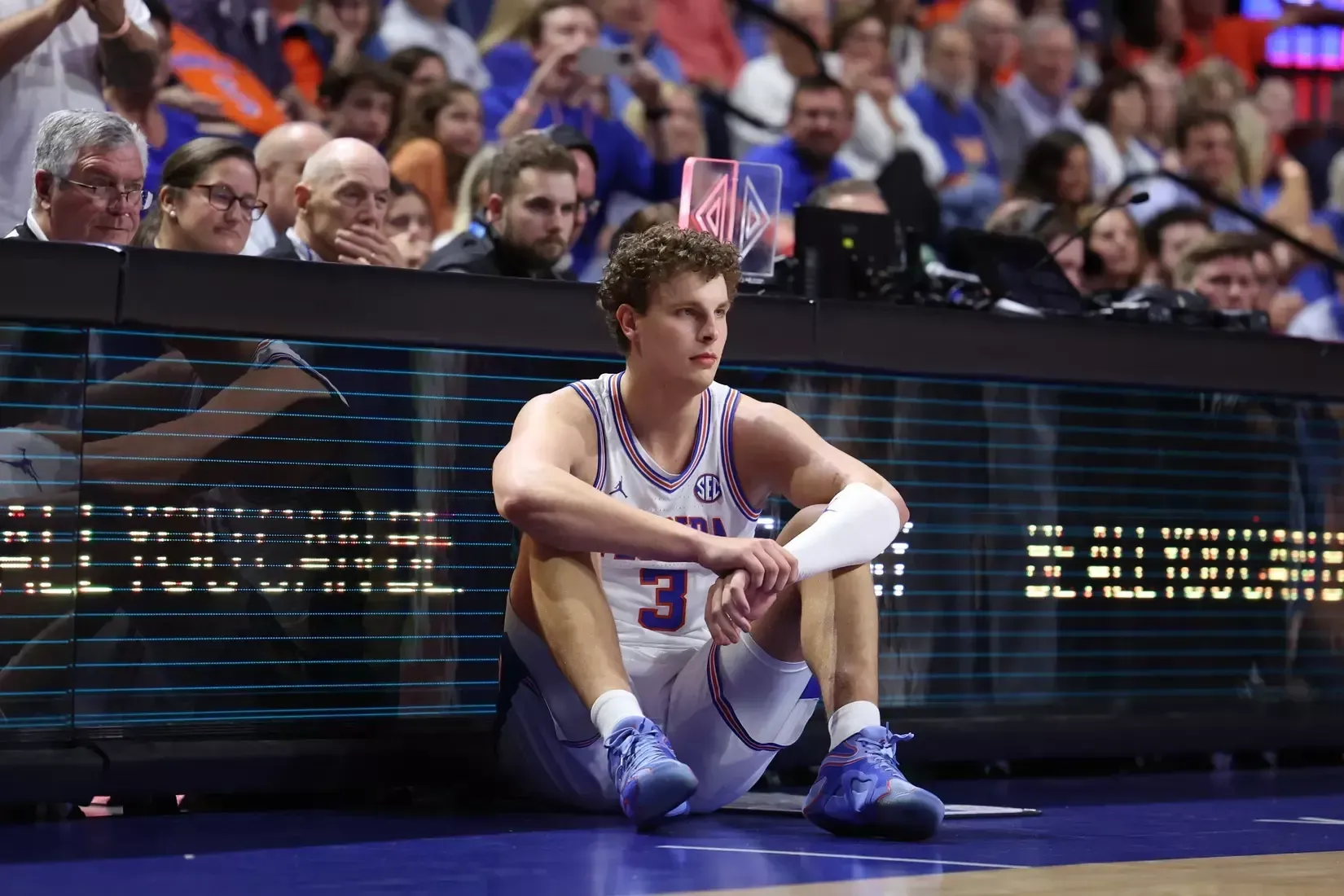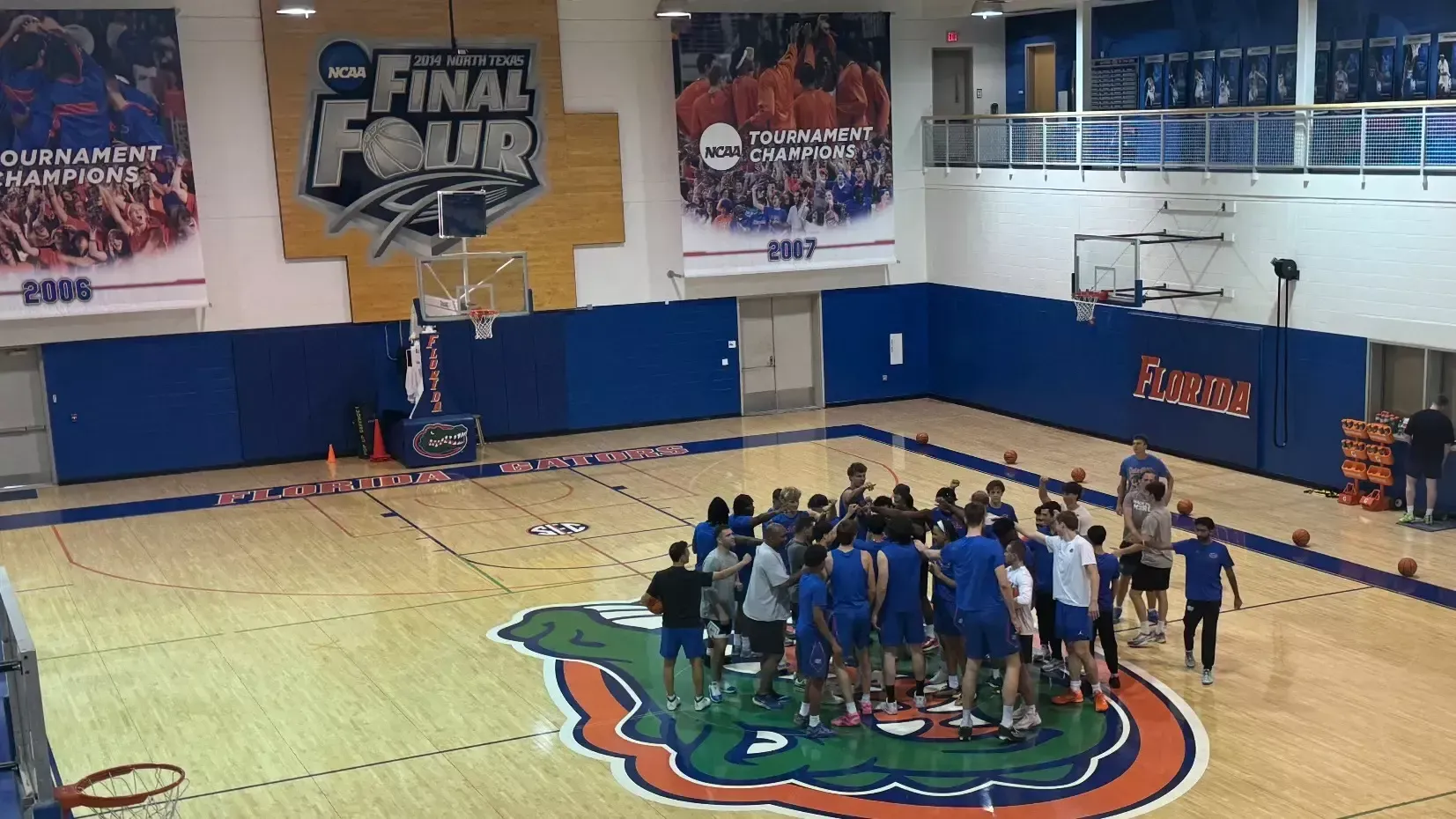
The Florida men's basketball team, five months removed from winning the national championship, officially tips off 2025-26 fall practice Monday.
Chris Harry breaks down roster shifts, coaching changes, and championship expectations as the Gators tip off a new era.
So here we are again, nudging our way toward the start of the college basketball season, the preparation for which actually began way back in April when new guys arrived and former players bolted. But this season – this Florida basketball team – has a different feel.
The intensity and competitive fire that defined last summer’s workouts at the Hugh Hathcock Basketball Complex were unmistakable. The return of elite scorer Walter Clayton Jr., a more polished Will Richard, and the defensive edge brought by Alijah Martin gave Florida a daily dose of leadership and grit. Their impact was undeniable—we’ve seen the results, felt the energy, and held the hardware. Now, all three are off to the NBA.
Still, the reigning NCAA champions aren’t starting from scratch. Florida brings back a strong core, anchored by what many consider the deepest and most dominant frontcourt in the country. Head coach Todd Golden and his staff faced the challenge of filling—not replacing—the void left by the trio of Clayton, Martin, and Richard. So far, the early signs point to something more than just promising.
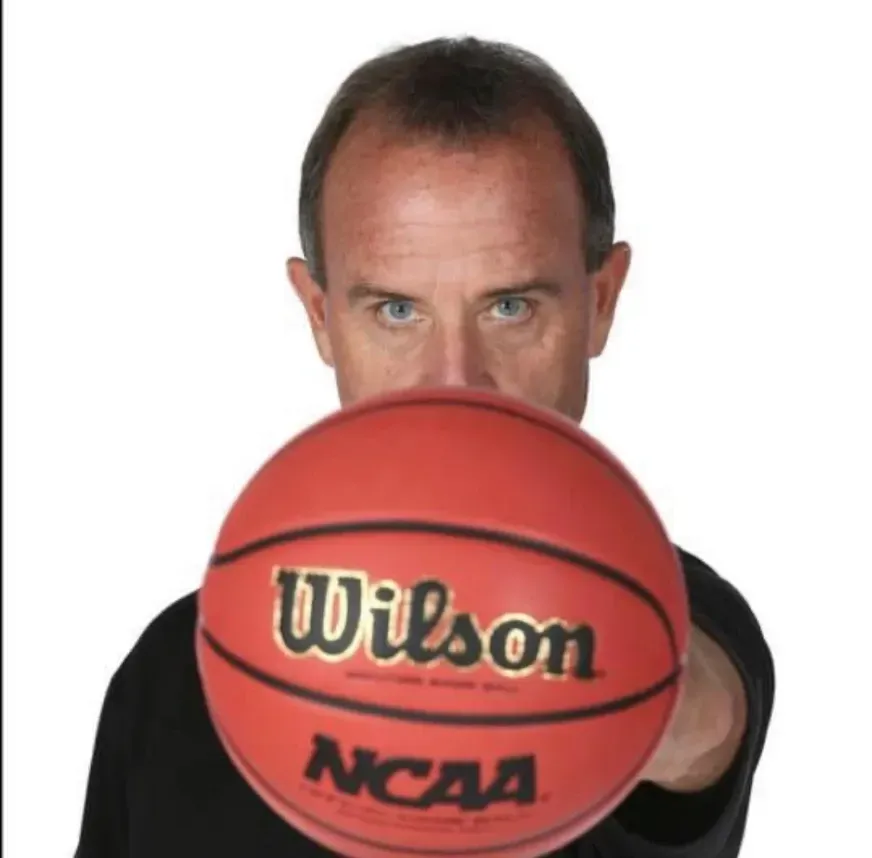
Chris Harry
Here we are again—Florida officially tips off fall practice on Monday. The role projections below stem from summer workouts, individual instruction sessions, and pickup games. They’re fluid, of course (I’ve missed a few in this space before), as the season’s length, inevitable injuries, and player development will shape the final picture. The 2025–26 Gators are still carving out their identity, but the coaching staff has a solid grasp of what this group brings.
This year’s squad may not crack the top 10 in both offensive and defensive efficiency like last season’s did, but the goal is top 20 in both—a benchmark that statistically gives teams the best shot at winning it all. Florida should still be able to score in waves, though perhaps not with the same firepower (Walter Clayton Jr. might’ve been the best offensive player in the country). Defensively, it’s reasonable to expect a slight dip with Alijah Martin’s departure. Even so, Florida is projected to be the preseason favorite in the Southeastern Conference. Many analysts will pencil them into the Final Four conversation.
The season officially begins Nov. 3 vs. Arizona in Las Vegas.
Time to prime.
BEST PLAYER: Thomas Haugh
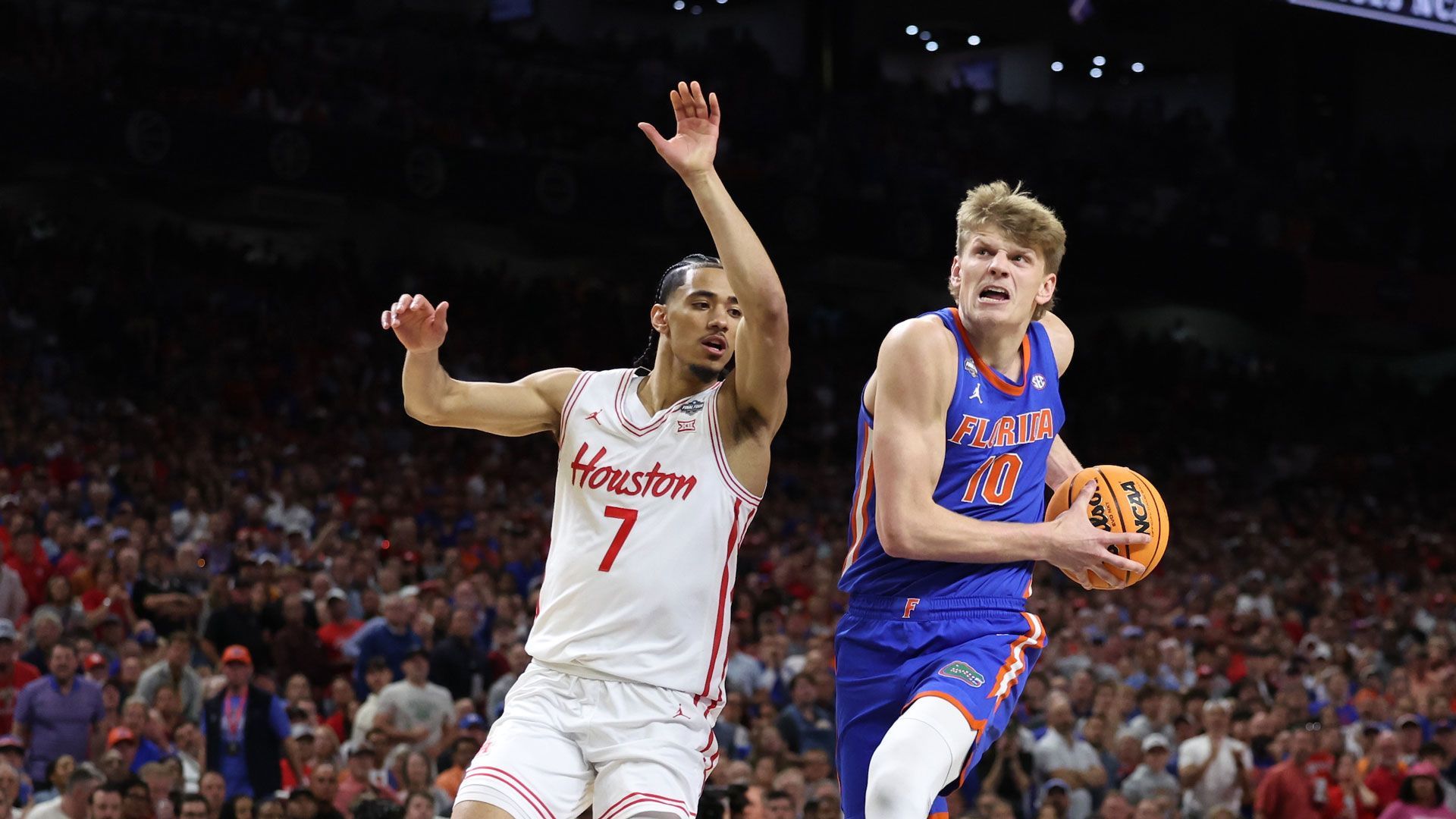
Thomas Haugh (10) made only five starts last season, but was one of three Gators to play in all 40 games, with his 973 minutes tops among the front court.
On a roster filled with high-level talent, naming a standout wasn’t taken lightly. Several players could’ve earned the nod based on past performance, but the selection was made with a clear understanding: Thomas Haugh, now a junior, is shifting from his role as a full-time power forward (“4”) to starting at small forward (“3”)—a position held primarily by Will Richard and his reliable perimeter shooting over the past three seasons.
The transition to the wing will be a new challenge for Haugh, but one that aligns with his growth over two seasons. Despite coming off the bench in all but five games last year, he ranked fifth in minutes (24.3), fifth in scoring (9.8), and third in rebounding (6.1). When stepping in for Alex Condon during a six-game stretch, Haugh averaged 31.5 minutes, 13.7 points, 60% shooting, 6.0 rebounds, and 3.5 assists. In a road win at Mississippi State, after Condon rolled his ankle just 30 seconds into the game, Haugh nearly posted a triple-double with 16 points, 9 rebounds, and 8 assists in 37 minutes.
As for the shooting demands at the “3,” Haugh’s offseason work paid off—he improved his three-point percentage from 25.5% as a freshman to 34.0% as a sophomore, just two points shy of Richard’s mark last season. He hit three or more triples in four games, including a career-high four in the Elite Eight comeback against Texas Tech.
Whether the move away from the paint affects his rebounding remains to be seen, but Haugh’s relentless motor suggests he’ll continue to be a force on the glass—whether grabbing boards himself or keeping possessions alive for teammates. He’ll still log minutes at the “4,” but his versatility is a major asset.
Haugh’s name has surfaced on several national “breakout player” lists this season. That’s not just an understatement—it’s almost dismissive. “Tommy” was one of the most impactful players in the country last season, delivering in high-pressure moments and carrying that momentum into the offseason.
BIG EXPECTATIONS: Alex Condon
After earning third-team All-SEC honors in 2025 with averages of 10.6 points and 7.5 rebounds over 25 minutes per game, Alex Condon explored the NBA evaluation process before making the call to return for his junior season—a decision that could pay major dividends.
The 6-foot-11, 236-pound Australian brings elite energy, sharp instincts, soft hands, and exceptional timing as a shot-blocker. His ability to run the floor makes him a standout in transition. “Condo” had stretches last season where he looked like one of the top big men in the country. He earned SEC Player of the Week honors three times, including the final week of the regular season when he posted career highs with 27 points at Alabama and 15 rebounds vs. Ole Miss.
In the NCAA Tournament, Condon faced a gauntlet of physical, pro-ready opponents and struggled through a four-game stretch with just 19 total points and some turnover issues. But he bounced back in the championship game against Houston, delivering 12 points, 7 rebounds, and 4 steals when it mattered most.
Twice during the season, Condon suffered ankle injuries—the first sidelining him for nearly four games. Despite the setbacks, he pushed through the pain and continued to contribute at a high level. Like his close friend and teammate Thomas Haugh, Condon’s effort is never in question.
If he continues his upward trajectory—adding polish to his finishes around the rim, improving his 60% free-throw shooting, and refining his three-point shot (29% as a freshman, 33% as a sophomore)—Condon could hear his name called in the first round. If everything clicks, the lottery isn’t out of reach.
FORCE: Rueben Chinyelu
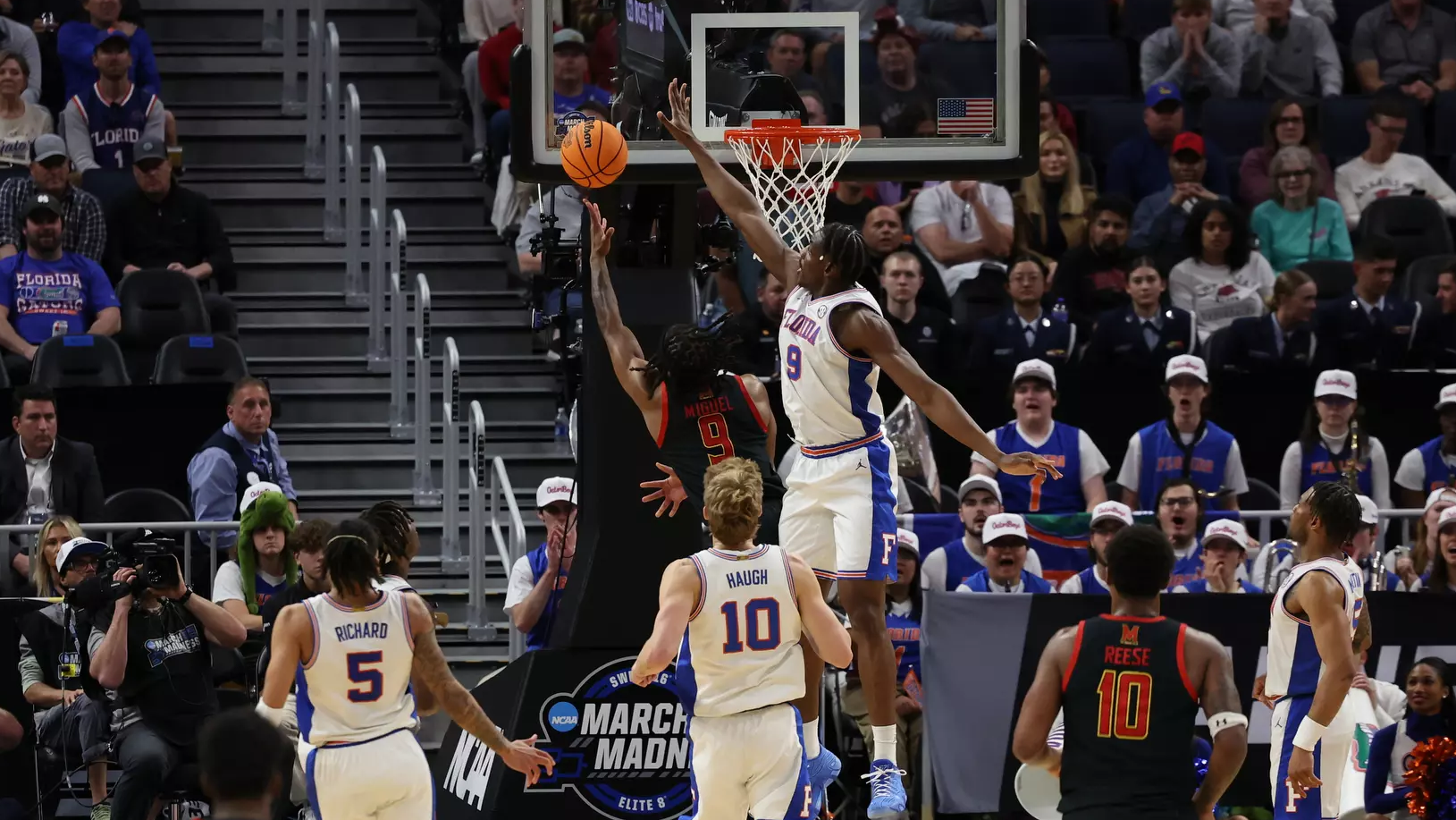
Center Rueben Chinyelu (9), as a sophomore, led the Gators in offensive rebound percentage (13.2), which ranked 52nd nationally and fifth in the SEC.
After earning third-team All-SEC honors in 2025 with averages of 10.6 points and 7.5 rebounds over 25 minutes per game, Alex Condon explored the NBA evaluation process before making the call to return for his junior season—a decision that could pay major dividends.
The 6-foot-11, 236-pound Australian brings elite energy, sharp instincts, soft hands, and exceptional timing as a shot-blocker. His ability to run the floor makes him a standout in transition. “Condo” had stretches last season where he looked like one of the top big men in the country. He earned SEC Player of the Week honors three times, including the final week of the regular season when he posted career highs with 27 points at Alabama and 15 rebounds vs. Ole Miss.
In the NCAA Tournament, Condon faced a gauntlet of physical, pro-ready opponents and struggled through a four-game stretch with just 19 total points and some turnover issues. But he bounced back in the championship game against Houston, delivering 12 points, 7 rebounds, and 4 steals when it mattered most.
Twice during the season, Condon suffered ankle injuries—the first sidelining him for nearly four games. Despite the setbacks, he pushed through the pain and continued to contribute at a high level. Like his close friend and teammate Thomas Haugh, Condon’s effort is never in question.
If he continues his upward trajectory—adding polish to his finishes around the rim, improving his 60% free-throw shooting, and refining his three-point shot (29% as a freshman, 33% as a sophomore)—Condon could hear his name called in the first round. If everything clicks, the lottery isn’t out of reach.
PEDIGREE PRO PROSPECT: Boogie Fland
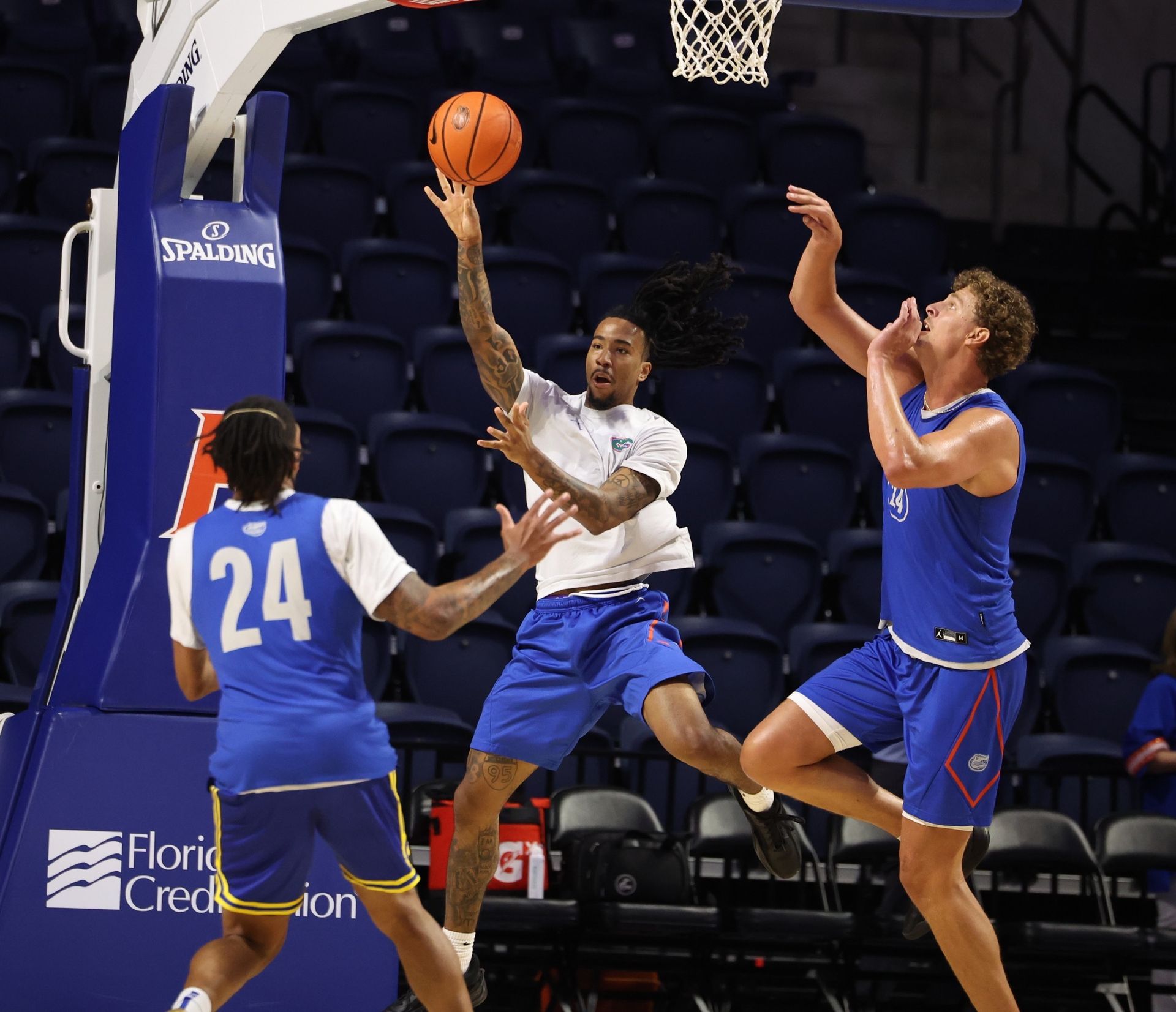
Guard Boogie Fland (center), the transfer from Arkansas, will again be one of the fastest player in the SEC (heck, in the country); maybe even faster as he enters his sophomore season fully healthy.
It’s been a while since Florida welcomed a former McDonald’s All American to its roster—not since 2019, when the Gators signed Scottie Lewis and Tre Mann out of high school. That streak ends with Boogie Fland, who arrives in Gainesville after a freshman season at Arkansas marked by both promise and adversity.
Despite entering the year with a hernia and missing 15 games due to torn wrist ligaments, Fland still averaged 13.5 points, 3.2 rebounds, and 5.1 assists. When preseason practice begins next week, he’ll be the healthiest he’s been since stepping onto a college court and is expected to take over the “PG1” role vacated by Walter Clayton Jr.—though in a shared setup with another newcomer.
A Bronx native, Fland might be the fastest player to join the Gators since Chris Chiozza, which bodes well for Florida’s transition game. While technically a combo guard, his 3.7 assist-to-turnover ratio (second in the SEC) highlights his unselfish playmaking. At 6-foot-3 and 185 pounds, he’s more physical and athletic than his frame suggests.
Fland shot 37.9% from the field and 34.0% from three last season—numbers the staff expects to climb, especially with a focus on improving his finishing around the rim. One of the most intriguing storylines heading into fall practice will be how Florida’s coaches build an offensive system around two ball-dominant guards who both excel at distributing the basketball.
SUPER-SKILLED TRANSFER: Xaivian Lee
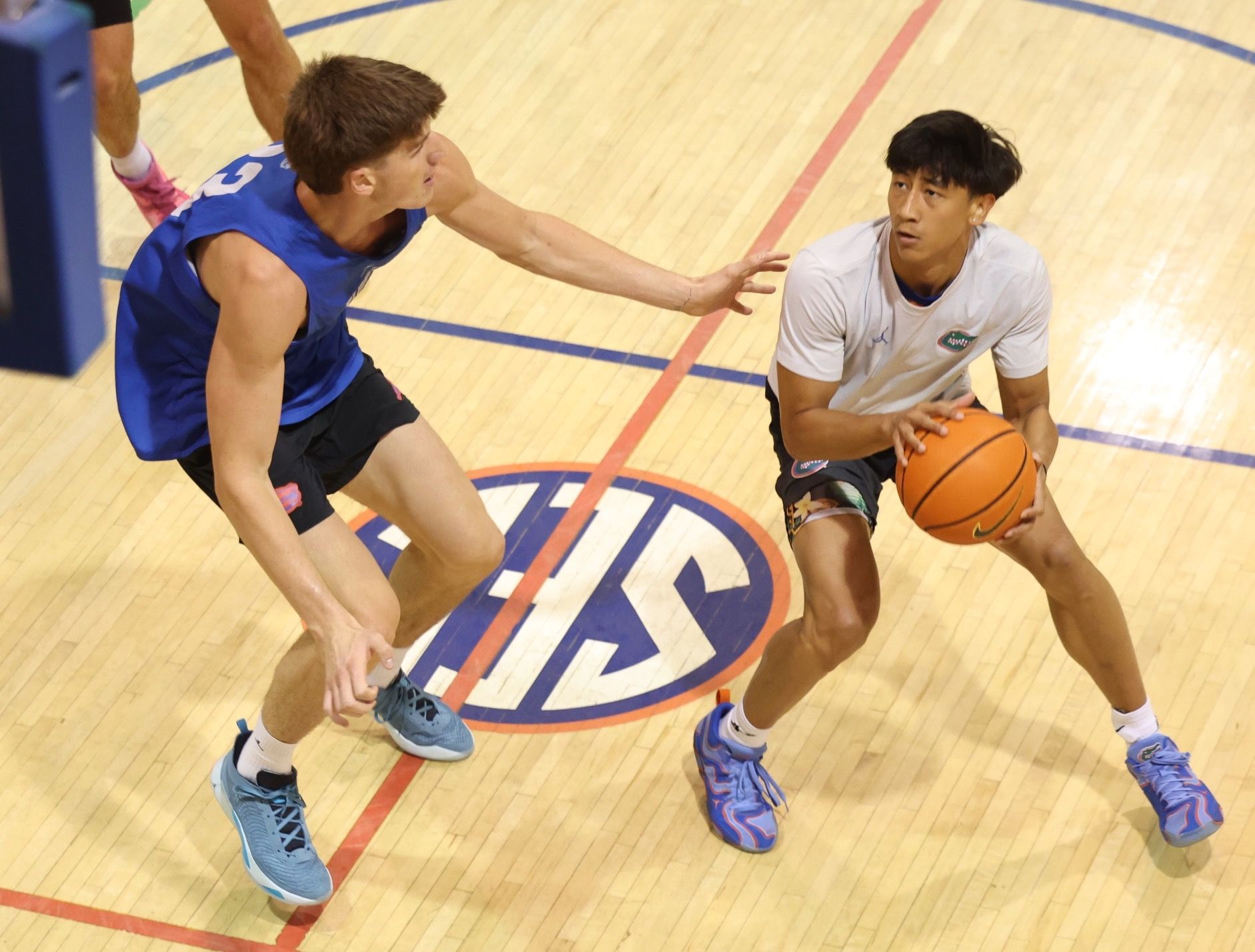
Guard Xaivian Lee (right) ranked 75th nationally in offensive usage (29.2%) and 19th in assist (36.8%) during his 2025 first-team All-Ivy League junior season at Princeton.
Rounding out the projected starting five is Xaivian Lee, a 6-foot-4, 183-pound guard and two-time first-team All-Ivy League selection from Princeton. While he’s slotted at the “2” shooting guard spot, his role—and that of Boogie Fland—is expected to be fluid, with both capable of initiating the offense.
Lee posted impressive numbers last season: 16.9 points, 6.1 rebounds, and 5.5 assists per game. He ranked 75th nationally in usage and 19th in assist rate (36.8%), leading the Ivy League in field-goal attempts with 408. His ability to create off the dribble and generate separation makes him Florida’s top option in late-clock situations.
He shot a career-best 36.6% from three-point range in 2024–25, though he only attempted 161 triples—significantly fewer than Walter Clayton Jr. (303), Alijah Martin (226), and Will Richard (223). That lower volume stemmed from Princeton’s limited offensive depth, which made Lee the focal point of opposing defenses and reduced his catch-and-shoot chances.
With Florida’s emphasis on ball movement—both side-to-side and inside-out—Lee is expected to see more open looks than ever before. Capitalizing on those opportunities will be key. He’s also a proven facilitator: his 165 assists last season would’ve led the Gators, and he did it in 10 fewer games.
Lee will face a steeper physical challenge in the SEC, where size and athleticism ramp up considerably. But his skill set and poise suggest he’s ready to adapt. At the line, he’s a career 79.6% free-throw shooter, while Fland hit 83.3% at Arkansas—making both reliable closers in tight games.
FULL-GO FRONT COURT LUXURY: Micah Handlogten
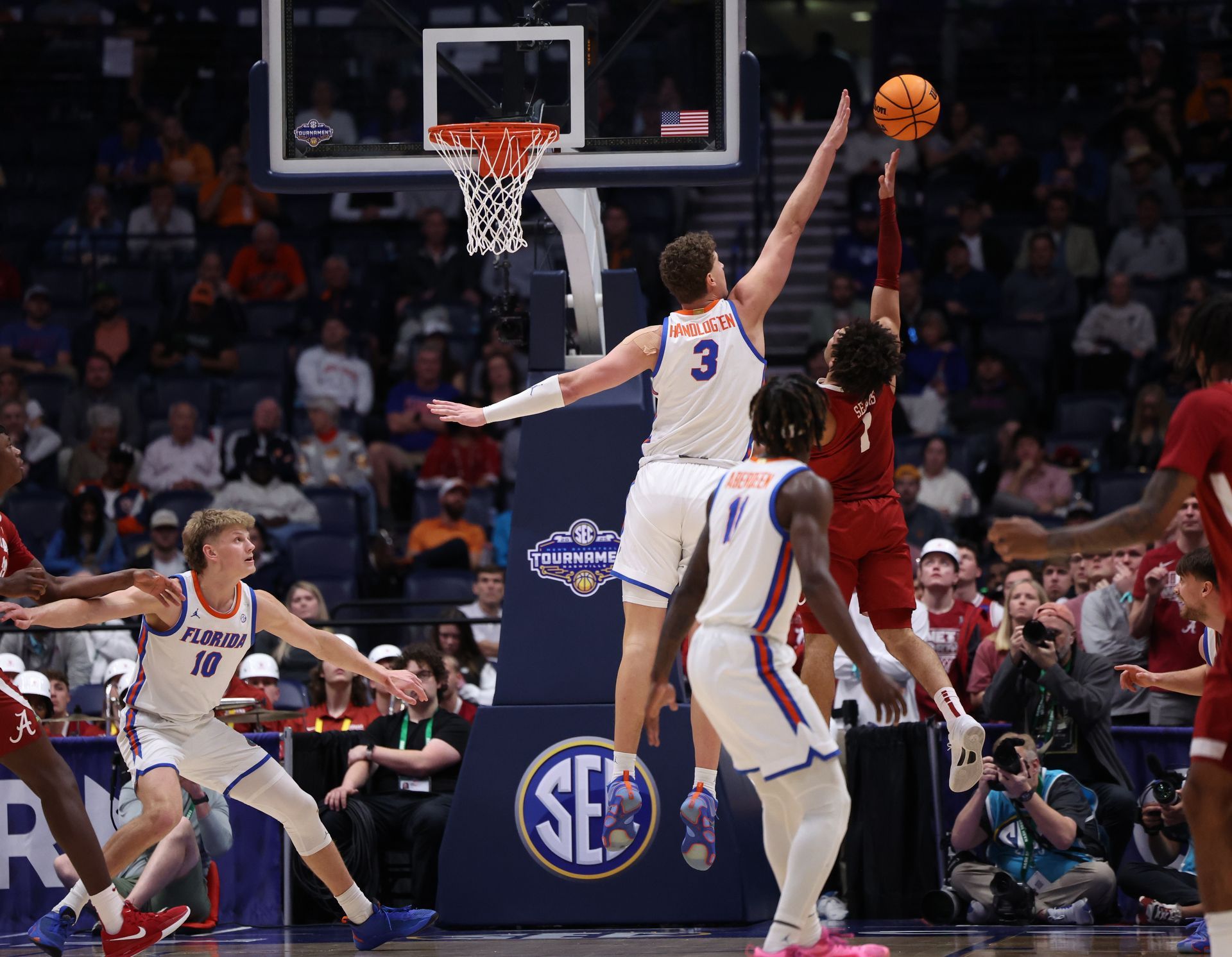
Senior Micah Handlogten (3), a terrific passer and one of the nation's best offensive rebounders, is not only 100% healthy but in the best shape of his college career.
Consider the range of preseason narratives surrounding Micah Handlogten, Florida’s 7-foot-1 senior. In 2023–24, he arrived from Marshall as the starting center for a program in rebuild mode under Todd Golden’s second-year leadership. By 2024–25, he was expected to take a medical redshirt after suffering a devastating compound leg fracture in the SEC Tournament. Now, entering 2025–26, he’s stronger, healthier, and in peak condition—ready to be one of the top big men in the country… as a backup. And he’s completely fine with that.
Handlogten’s decision to forgo the redshirt and return midseason last February was both surprising and selfless, giving Florida critical frontcourt depth during its national title run. A locker room favorite, he averaged 2.6 points and 13.3 minutes across 16 games, but his rebounding impact was undeniable: nearly five boards per game, with a 21.5% defensive rebounding rate (second-best on the team) and a team-high 13.7% on the offensive glass.
Now back at full strength and up to 260 pounds, Handlogten will anchor Florida’s three-man center rotation alongside Rueben Chinyelu and Alex Condon, forming what may be the deepest frontcourt in college basketball. Opponents will have their hands full when Chinyelu and Handlogten share the floor—yes, that’s happening.
Handlogten is a savvy passer from the low block, keeping the offense fluid and excelling at kick-outs off offensive rebounds. To earn crunch-time minutes, though, he’ll need to improve his free-throw shooting, which sits at 33.3% over two seasons, including 2-for-11 (18.2%) last year.
BEST SHOOTER: Urban Klavzar
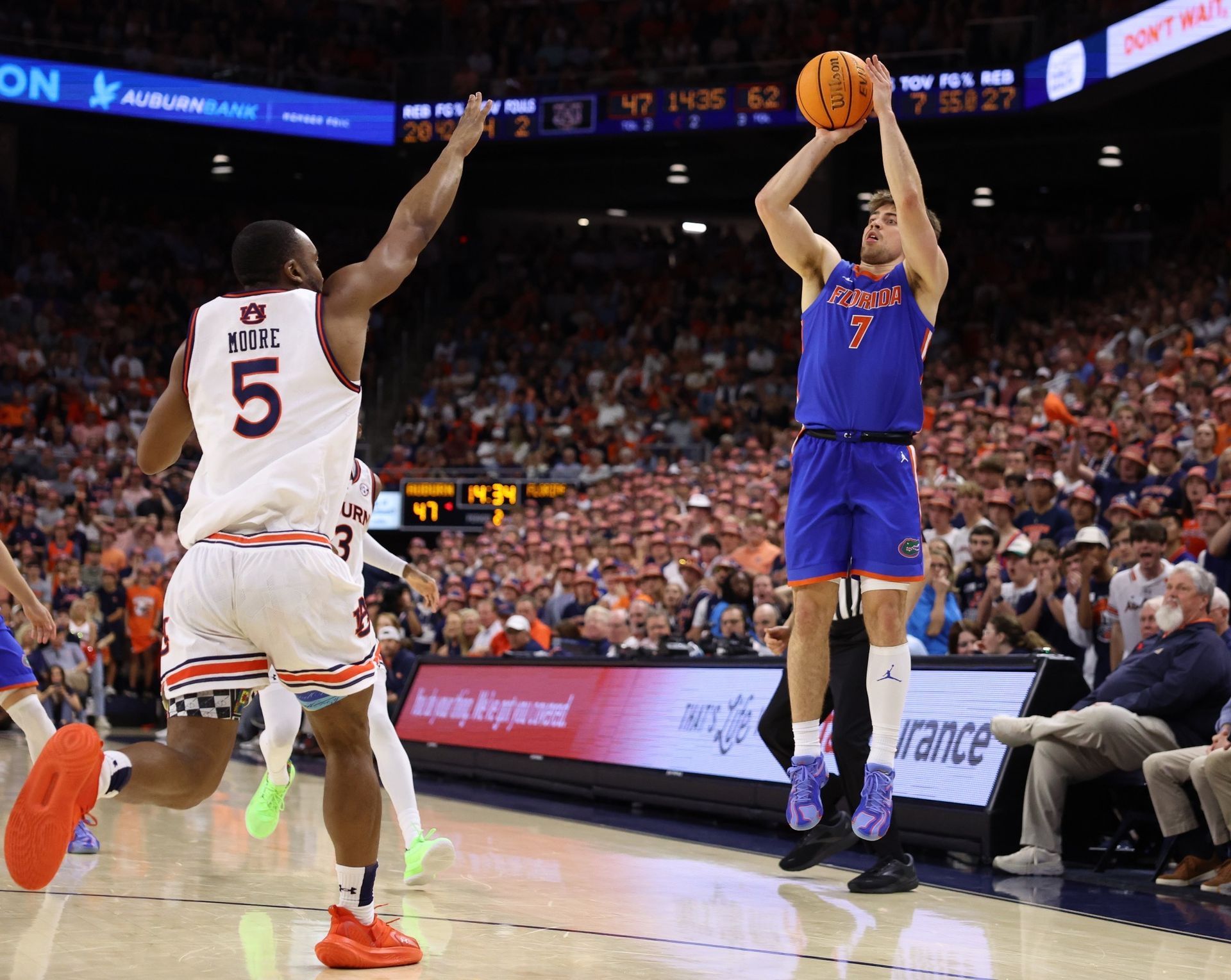
Urban Klavzar (7) had a streak of seven consecutive SEC games with at least one made 3-pointer off the bench.
When Luka Klavžar arrived late last summer after a stint with Real Madrid, many UF fans and media mistakenly assumed he was a point guard. That’s never been his role—and won’t be this season either. While he’s capable of making plays, Klavžar’s true identity is clear: an elite spot-up shooter.
His freshman year started slowly, in part due to an uncertain eligibility status that kept him sidelined until the fourth game of the season. That limbo weighed heavily on his preseason rhythm. Klavžar missed 12 of his first 13 three-point attempts, likely pressing to make the most of limited minutes. But once injuries sidelined Alijah Martin and Walter Clayton Jr., Klavžar stepped up—going 11-for-19 from deep over a seven-game SEC stretch.
His minutes dipped in the postseason as defenses tightened and denied him clean looks. He finished the year averaging 3.2 points in 10 minutes across 26 games, shooting 34% from beyond the arc. Though he didn’t play after the Sweet 16, Klavžar remained a high-energy presence on the bench.
This summer reaffirmed his reputation as having the smoothest stroke on the team, with Boogie Fland and Xaivian Lee learning to find him in transition. Heading into 2025–26, Klavžar is expected to be the first guard off the bench, with a focus on becoming a more complete player—starting with added strength and improved ball-handling in his second SEC campaign.*
HIS FOR THE TAKING: Isaiah Brown
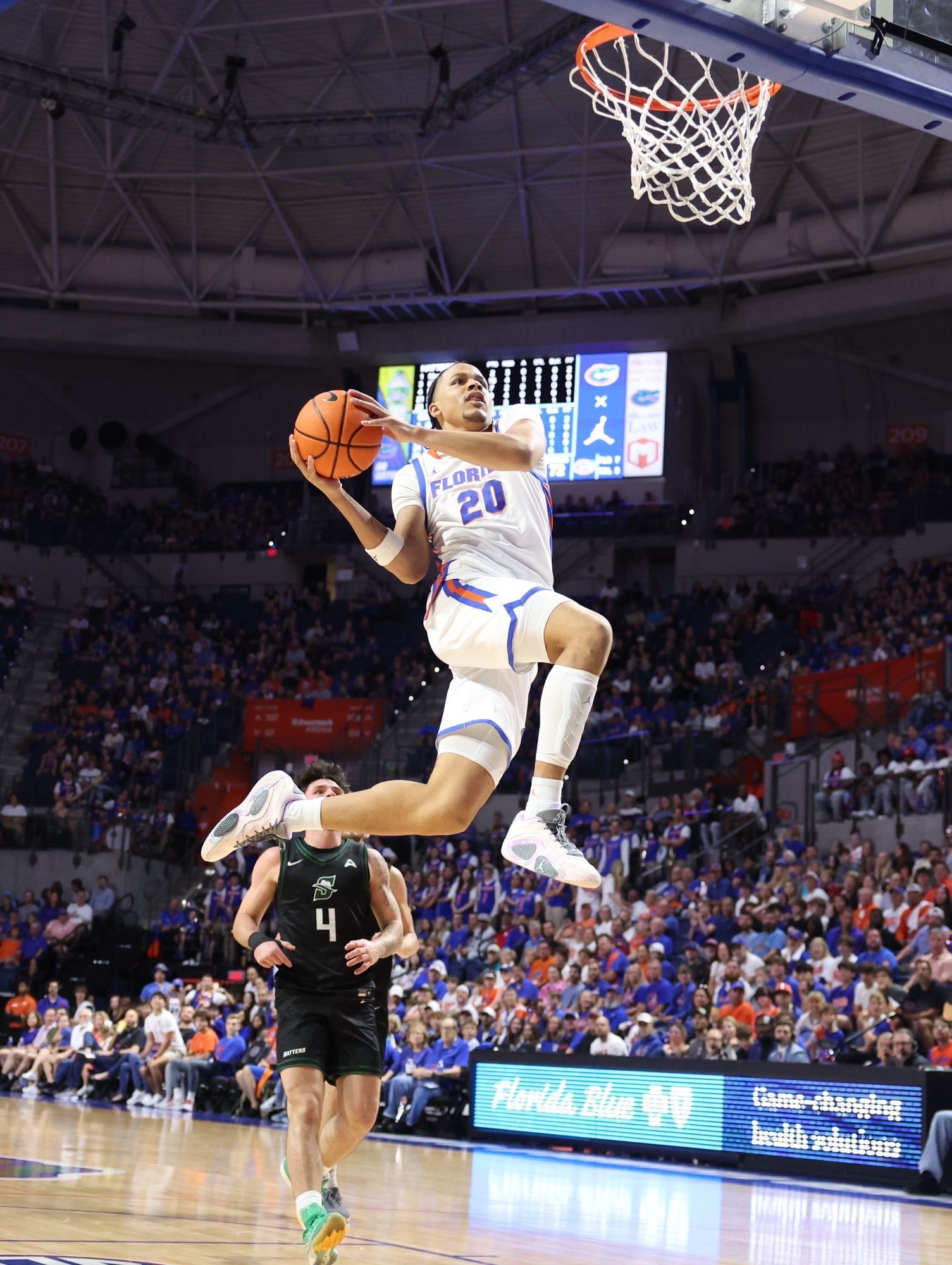
Sophomore wing Isaiah Brown (20) is as bouncy as anyone on the UF squad.
Someone has to claim the backup “3” spot—a role that demands speed in transition, ball-handling, perimeter shooting, defensive versatility, and the ability to make winning plays in limited minutes. Florida’s coaching staff will give Isaiah Brown, a sophomore from Orlando, the first opportunity to step into that role behind Thomas Haugh.
Brown saw limited action as a freshman, scoring 36 points in just 3.8 minutes per game across 19 appearances, but his efficiency stood out: 52% shooting from the field, 3-for-8 from three, and his most meaningful minutes came when Walter Clayton Jr. sat out against Vanderbilt. He also turned heads on the scout team during practices and remained a high-energy presence on the bench.
The Gators will quickly learn how much they can lean on Brown, but the staff is hopeful he can become part of a developmental pipeline—similar to what they envisioned for Denzel Aberdeen—a four-year contributor who grows within the program and eventually steps into a leadership role.
For Brown, the key will be day-to-day consistency, both in practice and in translating that effort into game performance.
RECOVERING WILD CARD: AJ Brown
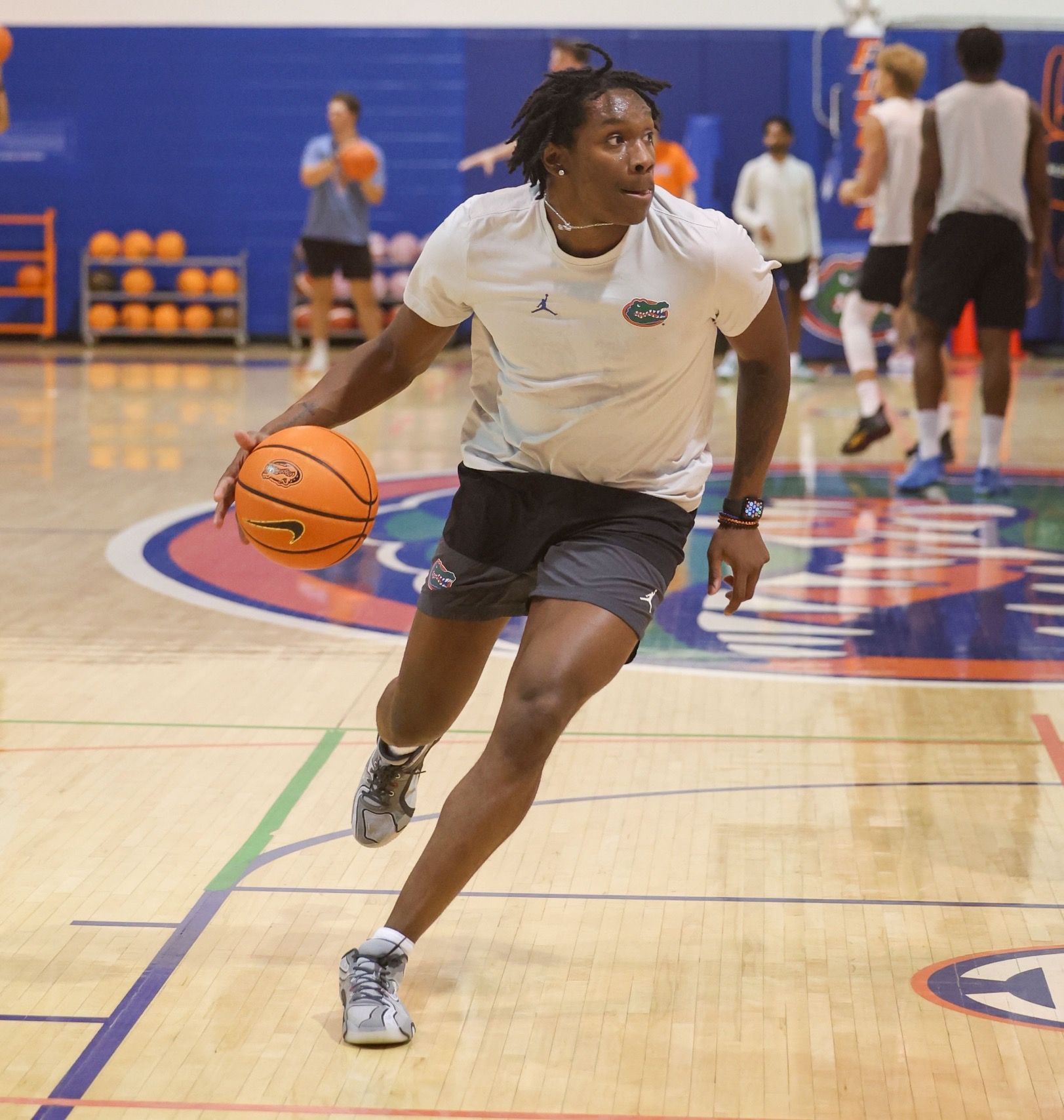
AJ Brown's effective field-goal percentage of 57.4 last season at Ohio ranked 173rd nationally.
Isaiah Brown’s older brother, a proven scorer from Ohio University, joins the Gators after averaging 13.2 points and nearly 39% from three as a junior in 2024–25. His season was cut short on March 1 due to a shoulder injury that required surgery. After entering the transfer portal, he landed at Florida and spent the offseason rehabbing, gradually returning to form. Though he’d been running and shooting for weeks, he was only cleared for contact last week, meaning he’ll begin preseason practices slightly behind in the competition for backup wing minutes—alongside his younger brother, Isaiah.
The elder Brown brings a solid résumé: six career games with 20+ points, a career-high of 28, and 12 games with at least three made threes. He’s also battled injuries throughout his college career, missing 35 games total (8 as a freshman, 24 as a sophomore, 3 as a junior), so his physical readiness will be key in determining his role.
When fully healthy, Brown has the potential to be a “microwave” scorer off the bench—similar to Luka Klavžar last season—but he’s more than just a spot-up shooter. His 50% career shooting from inside the arc and 77% free-throw accuracy on 176 attempts show a well-rounded offensive game.
Still, he’s only logged one week of full-contact work since arriving in the spring. The coaching staff will be watching closely to see how quickly he can ramp up and contribute.
FRESH(MAN) FACES: CJ Ingram & Alex Lloyd
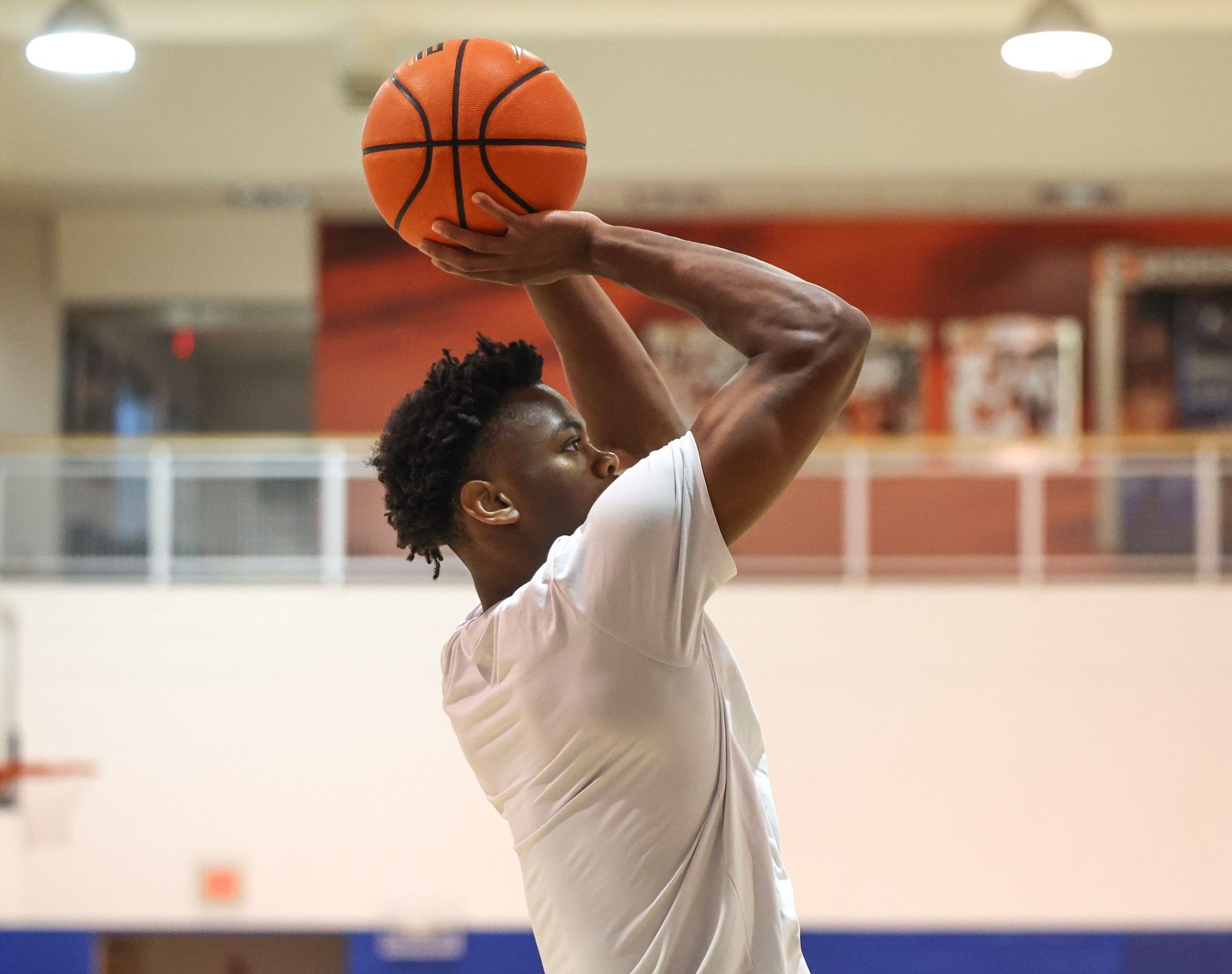
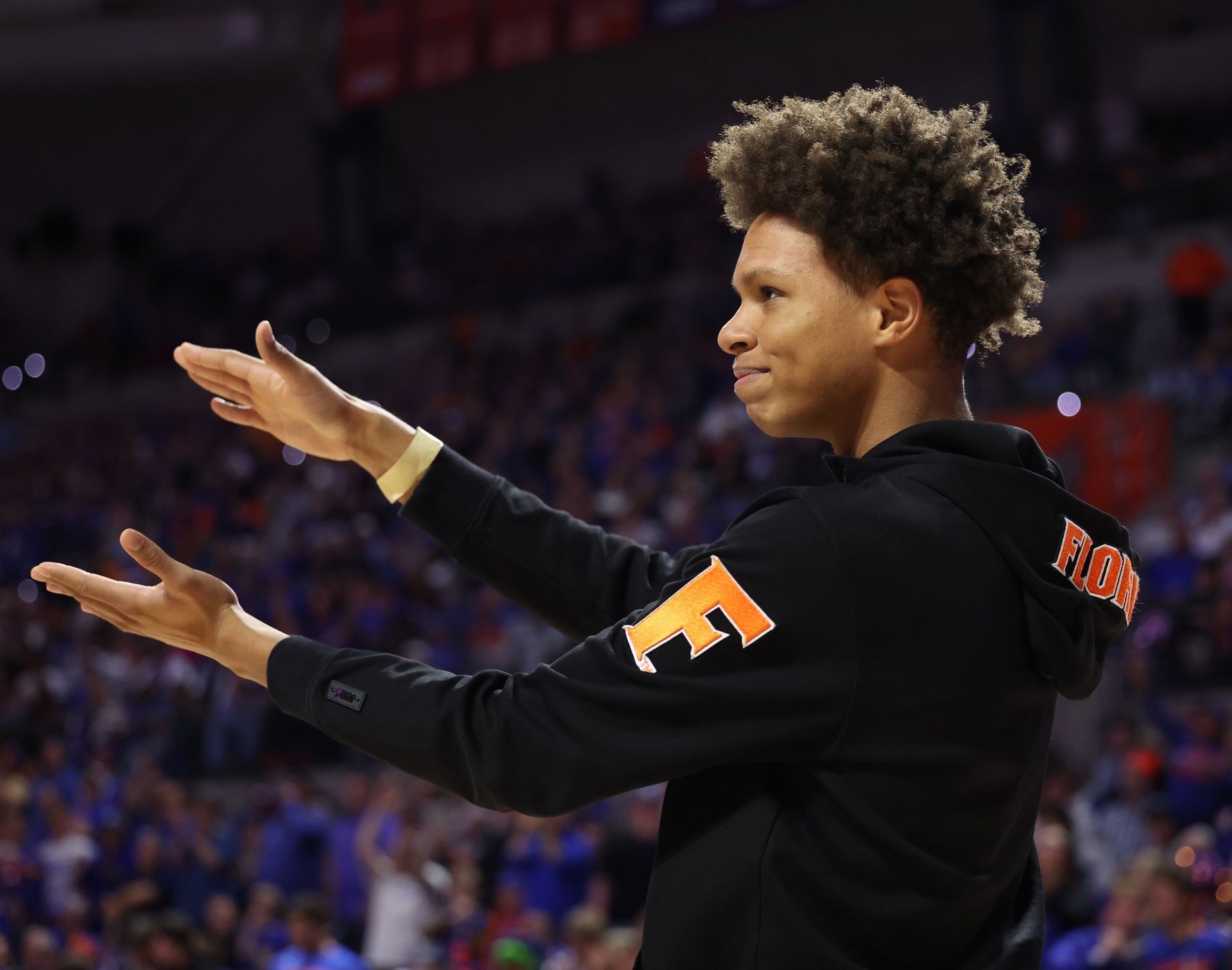
With two experienced, highly skilled transfers in the fold, plus a couple returning guards with a season in the UF system, freshmen CJ Ingram (top) and Alex Lloyd (bottom) likely will have to be patient and prove themselves to the coaching staff in their rookie college seasons, especially during practice.
Recruiting rankings can vary widely. For context, ESPN rated Florida’s two-man freshman class as the 22nd-best nationally and eighth in the SEC, while Rivals was less generous, placing it 47th overall and 13th in the league. It’s worth remembering that UF’s 2023 class—without any Top 100 prospects—ranked at the bottom of the SEC. FWIW: Condo and Haugh might disagree. Whatever.
The Gators are excited about their two newcomers: Ingram, a wing from Hawthorne, Florida and son of former UF tight end (and occasional Billy Donovan forward) Cornelius Ingram, and Lloyd, a combo guard from Miami Westminster who arrived with a well-rounded offensive game and immediately got to work improving it.
Ingram made waves on the club circuit last summer, thanks to his explosive athleticism, jumping from a top-125 prospect into the top 30. His shot still needs refinement, but he’s been a regular in the gym since arriving in May. Right now, he’s long, athletic, and bouncy, and once he settles into the system, he projects as a versatile defender who could potentially guard four positions. He’s not there yet.
Lloyd, meanwhile, is further along offensively. He has a strong feel for the game and may have a clearer path to early minutes than his classmate. As a senior, he averaged 27.9 points, including three games with 40-plus, and has impressed in pickup runs—especially with his jumper.
FIFTH FRONTCOURT BODY: Viktor Mikic
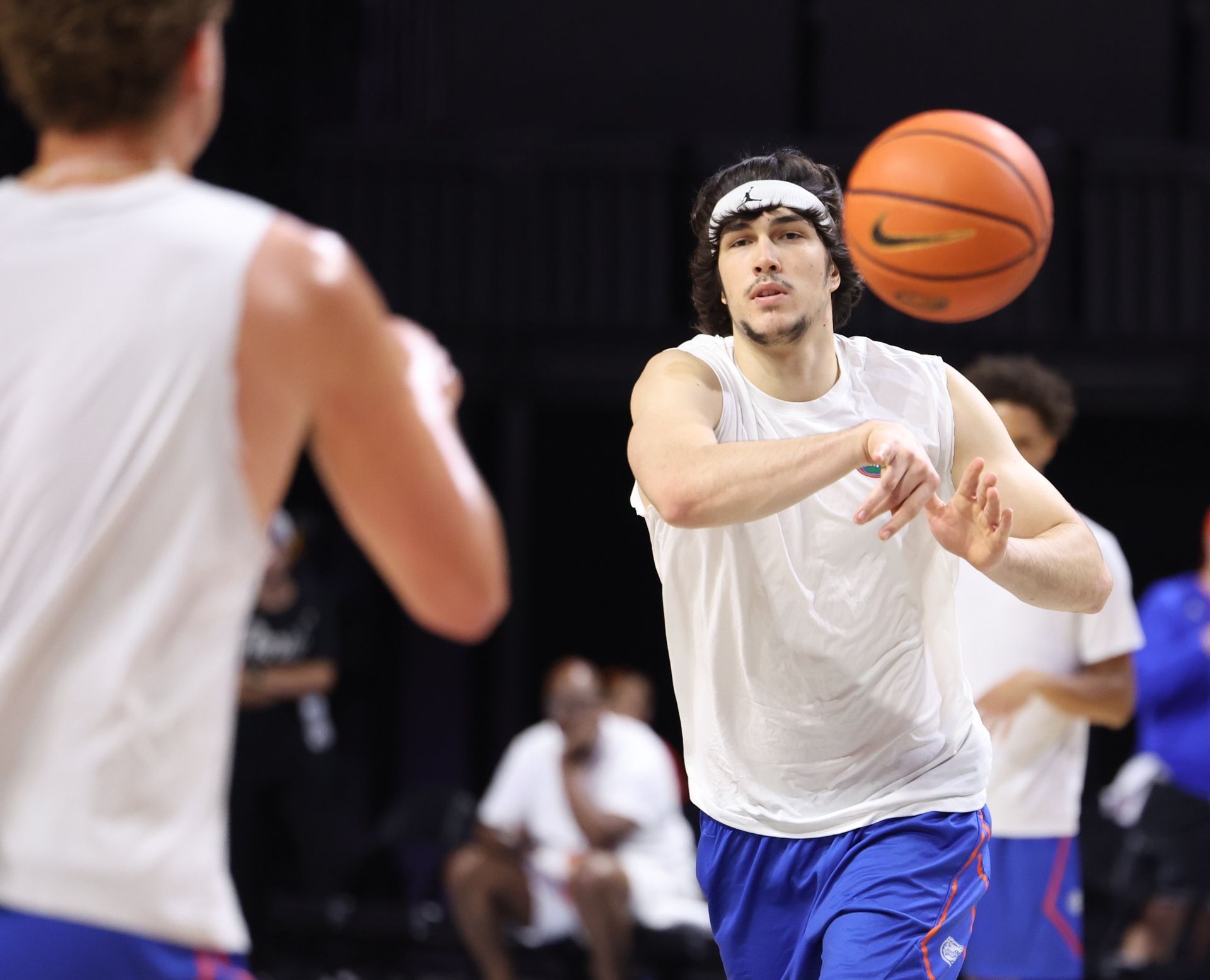
Viktor Mikic, who posted DNPs the final 32 games of the season, is back after a successful summer playing for his homeland in Europe.
Florida added Nikola Mikic, a 6-foot-11, 250-pound center from Serbia, during the summer of 2024 to bolster size and depth in the frontcourt—primarily to challenge Rueben Chinyelu and Alex Condon in practice. That’s exactly how his freshman season unfolded: Mikic logged just seven minutes across four games, with his final appearance coming during the Thanksgiving tournament in Orlando. He attempted only one shot and did not dress for the NCAA Tournament.
However, Mikic spent the summer back home representing Serbia in the FIBA U20 EuroBasket, where he averaged 10 points and 5.4 rebounds, offering a glimpse of his potential and giving Florida’s staff reason for optimism.
With Florida’s frontcourt rotation already stacked, minutes will be hard to come by. Still, with Thomas Haugh shifting to the “3” spot, a narrow window could open—if Mikic has made enough progress to step through it.
DOWN UNDER PRACTICE DEPTH: Alex Kovatchev
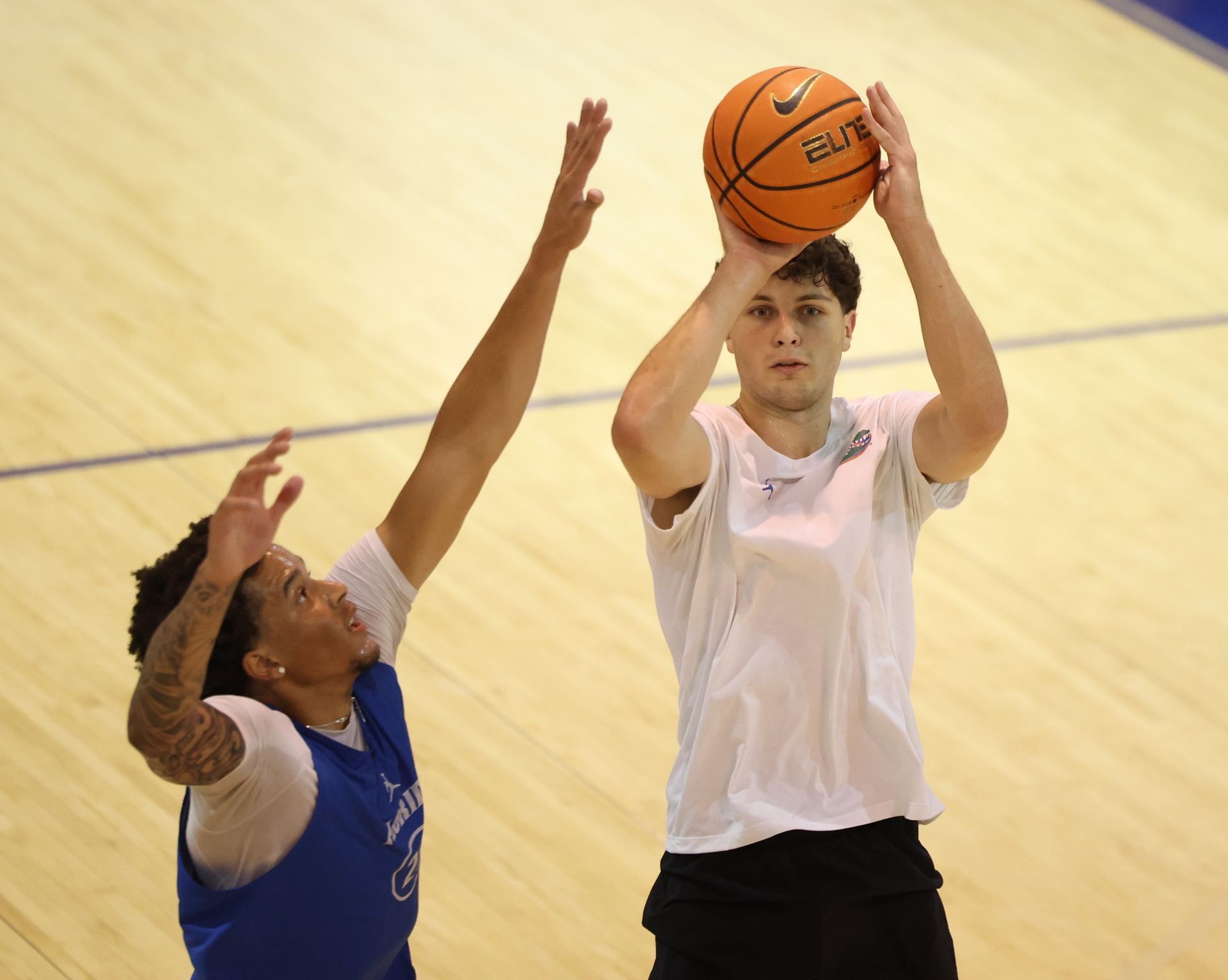
Summer-addition guard Alex Kovatchev (right) has 16 career Division I starts, which is 16 more than four of the five UF guards he'll be competing against for reserve time on the perimeter.
Florida entered the summer with 12 scholarship players, one shy of the NCAA limit, and filled the gap by adding Aleksa Kovatchev, a 6-foot-5, 190-pound guard from Sacramento State via the transfer portal. With AJ Brown still awaiting medical clearance, the Gators needed another backcourt option—and got one with a familiar twist: Kovatchev hails from Perth, Australia, just like Alex Condon. The two were teammates at the Basketball Australia Centre of Excellence, giving them instant chemistry.
Kovatchev, now a third-year sophomore, started 12 of 33 games as a true freshman in the Big Sky Conference, averaging 8.5 points and 5.0 rebounds before a broken leg ended his 2024–25 season after just four games. Since arriving in Gainesville, he’s impressed coaches with his feel for the game, court awareness, and quick grasp of the system.
While the SEC presents a significant leap in competition from the Big Sky, Kovatchev’s versatility and familiarity with Condon could help him carve out a role—especially on the wing.
THE WALK-ONS: Olivier Rioux & Cooper Josefsberg
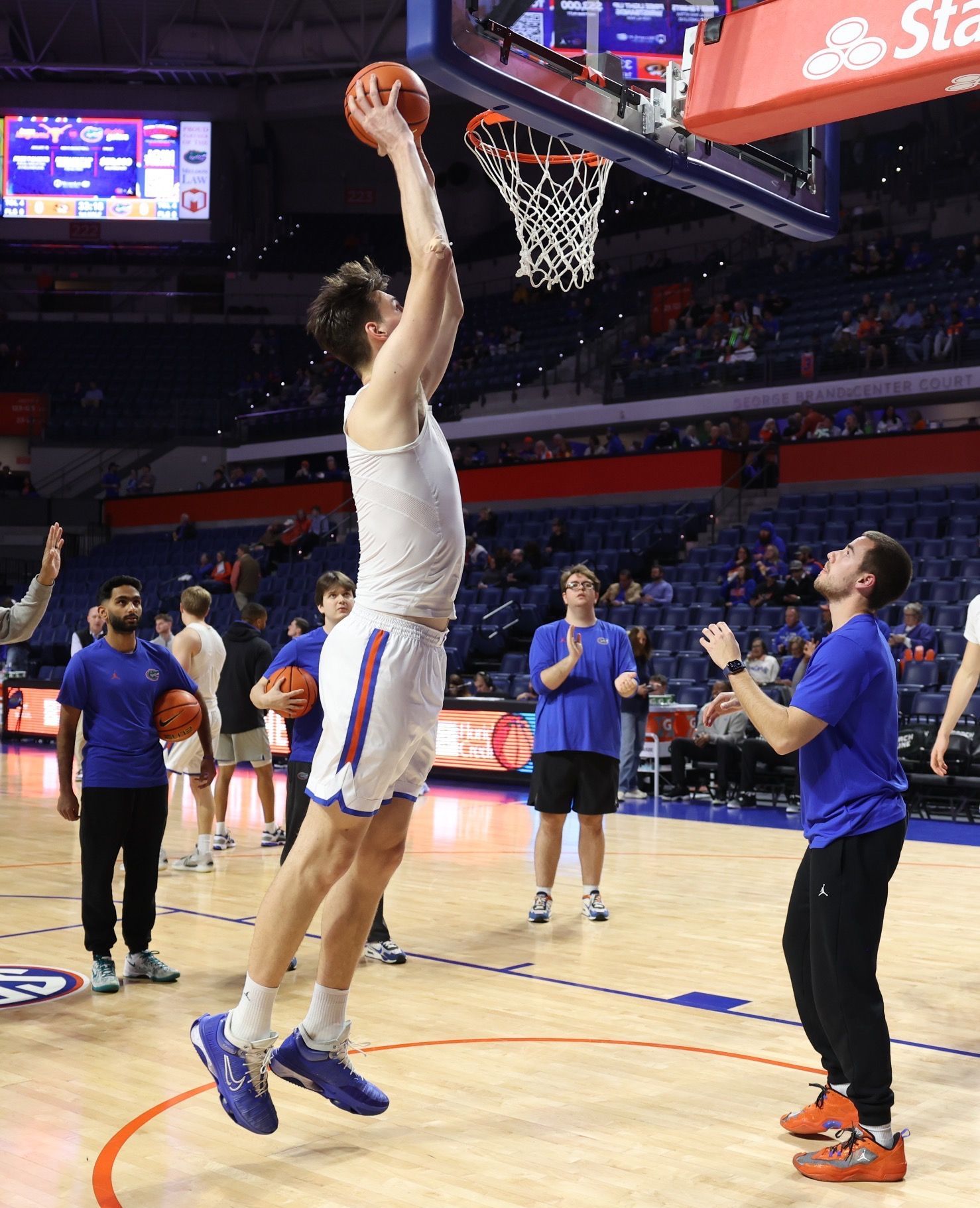
College basketball's tallest player (Olivier Rioux, top) and one of team's most popular players (Cooper Josefsberg, bottom) will be energetic fixtures on the UF sidelines again.
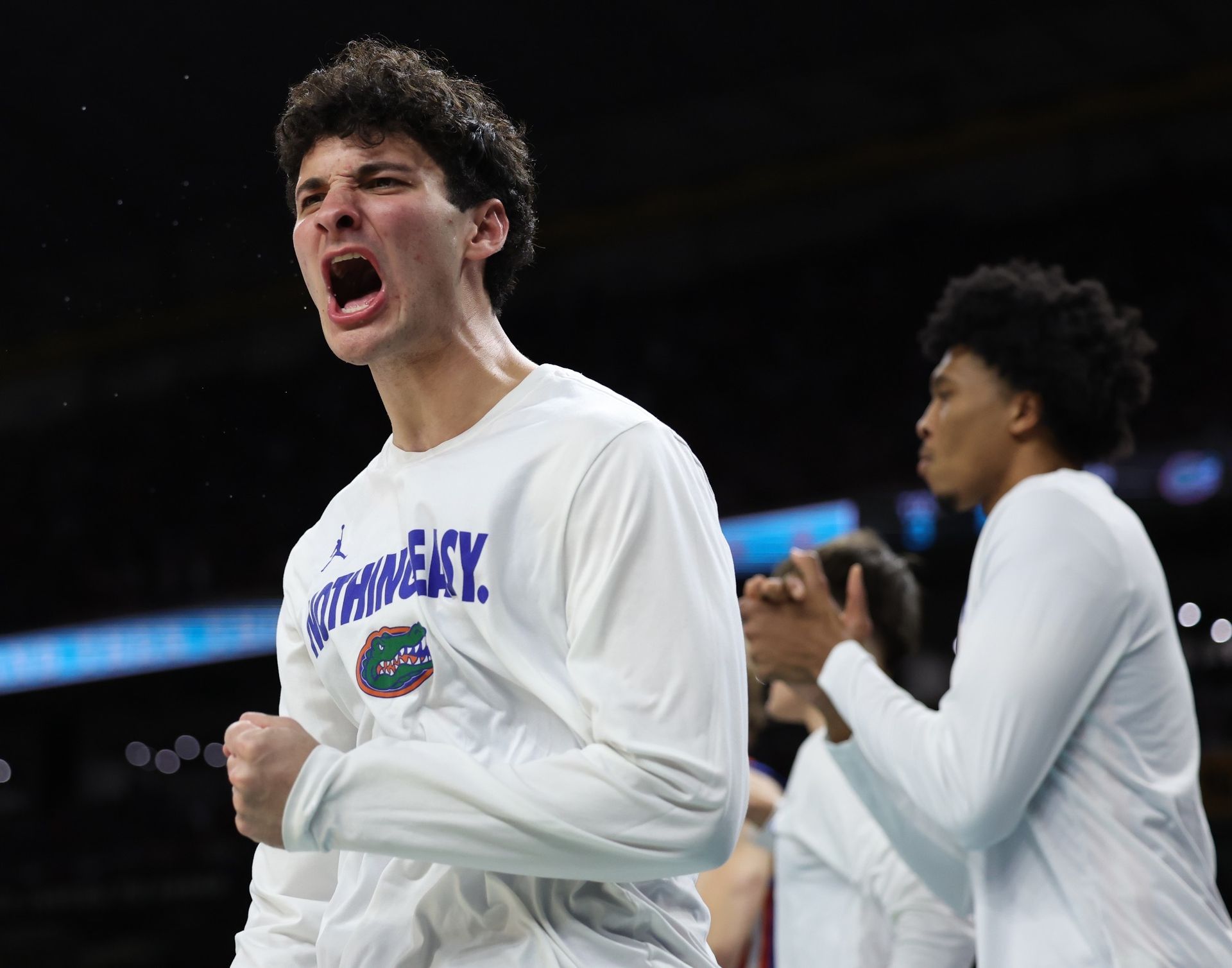
College basketball's tallest player (Olivier Rioux, top) and one of team's most popular players (Cooper Josefsberg, bottom) will be energetic fixtures on the UF sidelines again.
It’s safe to say Olivier Rioux became the most recognizable player in college basketball last season—despite never logging a minute of game action. At 7-foot-9 and 305 pounds, the tallest player in the sport spent most of the year focused on development and conditioning, participating in only a handful of practices.
Over the summer, Rioux suited up for Canada’s FIBA U19 World Cup team, averaging 1.6 points and 2.0 rebounds in about 10 minutes per game. His live-action reps remain limited heading into the fall, so 2025–26 will likely be another season of growth. Unlike last year, when a redshirt was the plan from the start, Rioux enters this season as a second-year freshman—and a likely fan favorite. Expect the Rowdy Reptiles to chant “WE WANT OLLIE!” during lopsided home wins.
As for Ben Josefsberg, the junior guard and team favorite appeared in four games last season without attempting a shot. That’s expected to change. In fact, it’s a safe bet he’ll take one this year—and an even safer bet he’ll make it.
